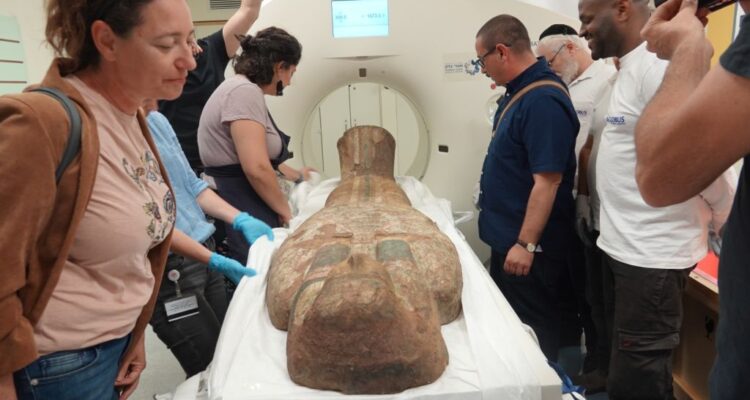“It is not every day that one witnesses the convergence of glorious history and technological advancements in the medical field.”
By Pesach Benson, TPS
In a meticulously planned operation that took five months to organize, a pair of 2,000-year-old coffin lids from ancient Egypt was transferred from the Israel Museum in Jerusalem to undergo a CT scan on Friday.
Part of the museum’s esteemed Egyptian collection, these intricate coffin lids carved from sycamore wood were subjected to an examination at Jerusalem’s Shaare Zedek Medical Center in order to unravel the techniques employed by craftsmen during their creation thousands of years ago.
The collaboration between the museum and the hospital could set a precedent for merging historical artifacts with cutting-edge medical technology to better understand the past.
CT (computerized tomography) uses a series of X-rays taken from different angles to create cross-sectional images of bones, organs and blood vessels. Usually, they are used to diagnose certain types of cancer, heart disease, blood clots, broken bones, bowel and spinal disorders, and broken bones, among other things.
“Through the scan, we were able to identify cavities in the wood that were filled with plaster as part of the preparation for the coffins’ decoration, as well as sections that were entirely cast from plaster instead of being directly carved from the wood,” said Nir Or Lev, the Israel Museum’s curator of Egyptian archeology.
“The examination has shed light on the craftsmanship of the ancient artisans responsible for creating these coffin lids, thereby significantly contributing to our ongoing research,” he said.
The first coffin lid, belonging to a ceremonial singer named Lal Amun-Ra, dates back to approximately 950 BCE. Inscribed on the lid are the words “Jed-Mot,” representing the name of the deceased, alongside a blessing. The second coffin lid, dating from the period between the 7th and 4th centuries BCE, once belonged to an Egyptian nobleman named Petah-Hotep.
“It is not every day that one witnesses the convergence of glorious history and technological advancements in the medical field,” said Shlomi Hazan, the chief radiologist of Shaare Zedek’s imaging department.
“The high-resolution scans enabled us to differentiate between various materials, such as wood, plaster, and air spaces. Moreover, the cross-sectional scans unveiled the tree rings, and three-dimensional reconstructions were generated to aid the research team in analyzing the composition of the different materials,” Hazan said.





